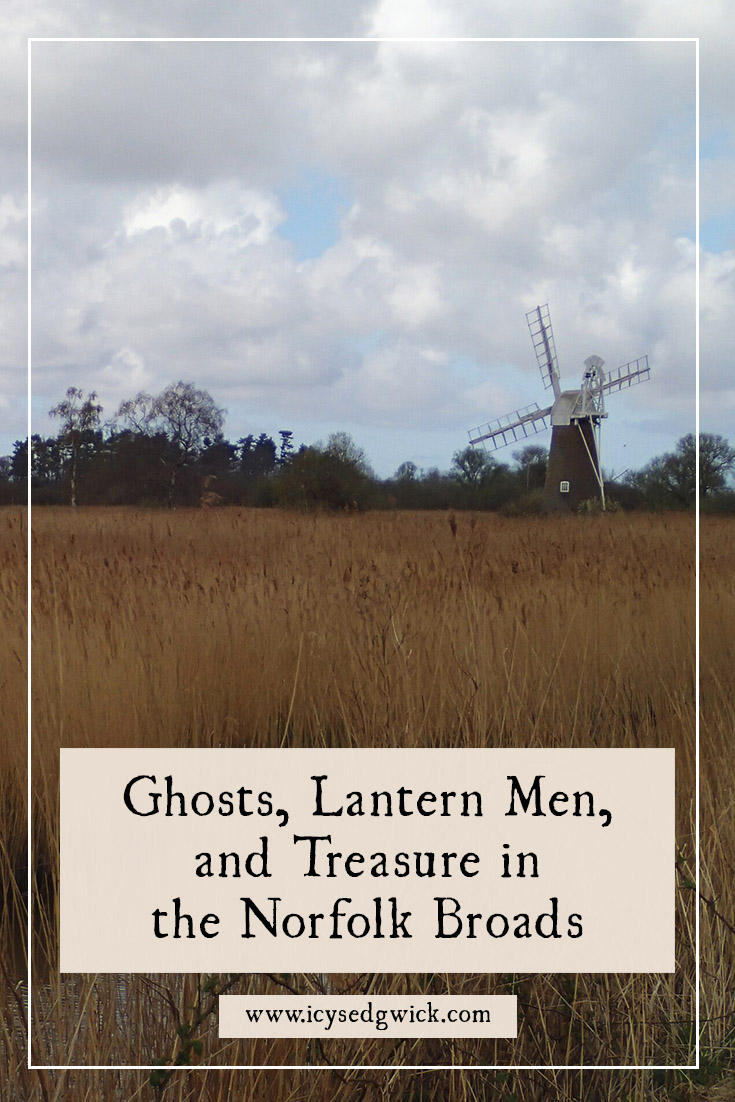The Broads National Park, often known as the Norfolk Broads, is one of the UK’s 15 National Parks. Seven rivers and over sixty waterways called Broads comprise the park.
In the medieval era, locals dug peat from the land for fuel. By the 14th century, these channels flooded and created the Broads. They’d become a popular boating destination by the 19th century. Here in the 21st century, the park is Britain’s largest protected wetland (Broads Authority 2025).
Unsurprisingly, the Park is also home to spectres, Otherworldly beings, and bogey beasts. Perhaps Norfolk’s most famous resident is Black Shuck. Yet there are also ghostly monks, phantom drummers, and the malicious Lantern Men.
Let’s go and meet them.
The Potter Heigham Drummer
A ghostly drummer boy apparently haunts the River Thurne at Potter Heigham in the Norfolk Broads. So who is he?
A drummer boy and the daughter of an influential local man enjoyed a secret relationship while he was on leave from the army in early 1815. It seems her father didn’t approve of the boy, and wanted his daughter to marry someone wealthy.

Still, his objections didn’t stop the pair from meeting. The boy skated across the frozen river to see her in a hut at the edge of Hickling Broad. He played his drum as he skated. Most sources don’t name the pair, although GM Dixon names them as John Sadler and Lilian Ducker (1987: 20). It’s unclear where those names come from, if it’s artistic license or part of a genuine tradition. The fact that no one else names them suggests the former.
Either way, the pair kept meeting in secret, but sadly, one night in February, the ice cracked. The boy fell into the freezing river and drowned. His girlfriend hadn’t realised what had happened, so when she saw him coming up the river, she thought all was well. He vanished when he reached her, at which point she realised something had happened to him. It took a few days to retrieve his body because no one could walk on the ice, but it was still too thick to get a boat through.
In some versions of the story, his ghost continues to skate on the river every year, although some sightings specify this happens in February (Westwood 2005: 506). A local version also specified that his ghost only skated on the ice, drumming as he went, to warn that the ice was too thin. Jennifer Westwood points out that this warning only appears in this single tradition, so it’s unclear if that’s part of the legend or something added by the writer (2005: 506).
Witnesses also report a female rower ghost on the River Thurne (The Paranormal Database 2025). I couldn’t find out anything else about who she might be.
Ranworth Broad
In the 1530s, Brother Pacificus, a monk at St Benets Abbey, took on the job of repairing a rood screen at St Helen’s Church in Ranworth. He and his dog rowed from the Abbey to the church in the morning, and they returned every evening.

One evening, he returned to a horrifying scene of violence and murder. Henry VIII’s soldiers had slaughtered his brother monks as part of the Dissolution of the Monasteries. A devastated and grieving Brother Pacificus remained alone at the Abbey. After he died, the locals buried him at St Helen’s.
People still see his sad figure rowing across the Broad to the church in the early morning, a ghostly dog still standing in the bow (Herbert Woods 2025).
The Callow Pit
A pit once lay between Southwood and Moulton parishes, known officially as ‘Callow Pit’ but referred to locally as ‘Caller Pit’. In 1855, Notes & Queries described the pit as having been more of a pond, although the water level regularly fell after new drainage went in. According to legend, an iron chest full of gold lay at the bottom of the pit, and two men decided to seize it for themselves.
One day, when the waters lay lower than usual, they laid ladders across the pit to form a platform. They managed to push a thick staff through the ring on the chest lid and heaved it out of the water. Lifting the staff up to their shoulders, they prepared to leave their makeshift bridge. One exclaimed, “We’ve got it safe, and the Devil himself can’t get it from us”. A cloud of sulphurous smoke surrounded them, and a hand and arm thrust out of the water. It grabbed the chest and wrestled it away from the men, only to sink back under the water. The men only managed to keep hold of the ring from the chest, which they added to the Southwood Church door (EGR 1855: 487).
Jennifer Westwood updates the story, adding that this church fell into ruin in the 1880s. According to legend, someone took the ring to the church at nearby Limpenhoe and fixed it on the north door. While the north door in churches across England was considered the Devil’s Door, at this church, it’s also their main entrance (2005: 515).

Who knows if the chest still lies at the bottom of the pond?
Silence while Treasure Hunting
This notion of keeping quiet while hunting for treasure is pervasive. A story from Lyng, near Dereham, featured a similar motif. In this story, from the start of the 19th century, two men pulled a silver chalice out of the River Wensum. One of them cried aloud, and the chalice jumped out of their hands and back into the water (Westwood 2005: 515).
Even in Northumberland, a man went treasure hunting at the behest of the ghost of Meg o’Meldon. One of the conditions was that he needed to remain silent throughout the entire operation. This appears in various tales of treasure hunting, often with the hunters beset by demons, witches, or even the Devil, all taunting them to speak. They only get to keep the treasure if they don’t.
The Wherryman’s Gravestone
The Wherryman’s Gravestone stands in Thurlton Churchyard. It bears a carving of a Norfolk wherry, marking Joseph Bexfield’s grave. 38-year-old Bexfield was a wherryman who drowned in 1809 on 11 August.

According to legend, Bexfield was a wherryman on the River Yare, working between Norwich and Yarmouth. He and his colleagues tied up their boats at Thurlton Staithe, halfway between these two towns, at night. One night, he and some friends went to the White Horse Inn across the marsh from the staithe. About to leave for home, he remembered he’d left some things for his wife on his wherry. His drinking buddies warned him to leave them, fetching them when it was light, because the Lantern Men were afoot in the marsh. They didn’t want their friend to fall victim to these terrifying Norfolk figures.
Bexfield scoffed at them and headed off across the marsh. No one saw him again until his body washed up between Reedham and Breydon. According to legend, people still saw a shadowy figure wandering in the marsh on misty nights, before disappearing into the river (Westwood 2005: 515). By the 1940s, the ghost disappeared from the story, replaced by the Lantern Men as the true danger of the marsh. It’s unclear if people feared the shadowy figure wandering in the marsh, or if he was more of a caution not to cross the marsh in the mist.
Lantern Men
With our focus on freshwater, I wasn’t originally going to include the Lantern Men. Yet their appearance in this story made their inclusion prudent, and marshes are freshwater spaces. Sometimes referred to in the singular, as the Lantern Man, it’s the name given to the ignis fatuus. This is also known as ‘foolish fire’, or ‘Will o’ the Wisp, which I’ve talked about before. The pragmatic explanation sees the lights being the result of marsh gas spontaneously combusting.

The folklore explanation sees these beings as entirely malevolent, hell-bent on luring people into ponds, bogs, or other unsafe spaces. People also believed the Lantern Men hated people carrying lanterns. In these stories, the Lantern Men would snatch a person’s lantern and break it. A story from the 1870s saw a man put his lantern down and run away, and when he looked back, the Lantern Man was engrossed in kicking the lantern. At least it proved to be a distraction, allowing the man to flee (Westwood 2005: 493).
It was important not to disrespect the Lantern Men. A Lantern Man knocked a man from his horse after the man called him ‘Will o’ the Wisp’, and another one followed an old man home who jeered at him. This is also a common trait in stories involving Otherworldly beings. If you can’t avoid them, treat them with respect, but do not trust them. That the stories involving the Lantern Men always happen at night is also important. Marshes and bogs are dangerous places by daylight, but when you can’t see where you’re going, they’re even more so. Tales of the Lantern Men become cautionary tales to warn people, especially lone travellers, away from dangerous natural spaces.
Have you been to the Norfolk Broads?
There are far more ghost stories related to the Norfolk Broads than I’ve covered here. After all, I wanted to focus on those stories involving water, as part of the Folklore of Freshwater theme! Yet as we found with canals, I wonder how much the presence of water ‘amplifies’ this spectral activity.

We can likely attribute the Lantern Men to the same phenomenon that produces the Will o’ the Wisp (though I’d never say that to a Lantern Man directly). The spectral monks speak to the often brutal history of the area, while the ghostly wherryman cautions against wandering in the marsh at night.
The phantom drummer at Potter Heigham is a sad story indeed, especially for a drummer who escaped the horrors of the Napoleonic War, only to drown in icy water at home. While we’ll never know if the name he’s given by GM Dixon was his real name, or if he even existed, he too provides a cautionary tale about venturing onto the ice.
But if you find yourself pottering about on a boat in the Broads, keep your eyes open. Who knows who—or what—you might see at daybreak or sunset…
References
Broads Authority (2025), ‘About the Broads National Park’, Broads National Park, https://www.visitthebroads.co.uk/discover-the-broads/about-the-broads. Accessed 17 May 2025.
Dixon, G.M. (1987), Folktales and Legends of Norfolk, Peterborough: Minimax Books.
EGR (1855), ‘Folk Lore’, Notes and Queries, 12 (321), p. 487.
Herbert Woods (2025), ‘Terrifying Tales from around the Broads’, Herbert Woods, https://www.herbertwoods.co.uk/blog/terrifying-tales-from-around-the-broads/. Accessed 13 May 2025.
The Paranormal Database (2025), ‘Ghosts & Folklore from Rivers & Waterways’, The Paranormal Database, https://www.paranormaldatabase.com/reports/riverdata.php?pageNum_paradata=3&totalRows_paradata=138. Accessed 13 May 2025.
Westwood, Jennifer and Simpson, Jacqueline (2005), The Lore of the Land: A Guide to England’s Legends, London: Penguin.
Nutty about folklore and want more?
Add your email below and get these posts in your inbox every week.
You'll also get my 5-step guide to protecting your home using folklore!







Have your say!